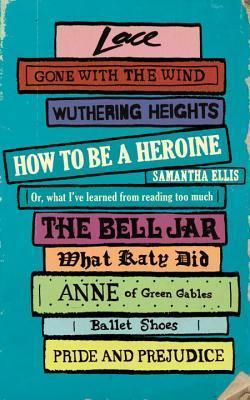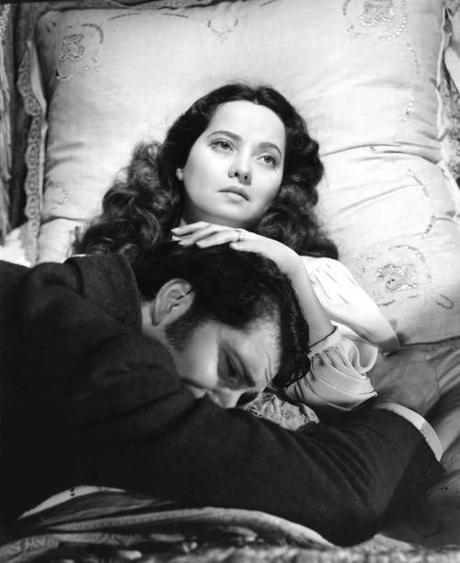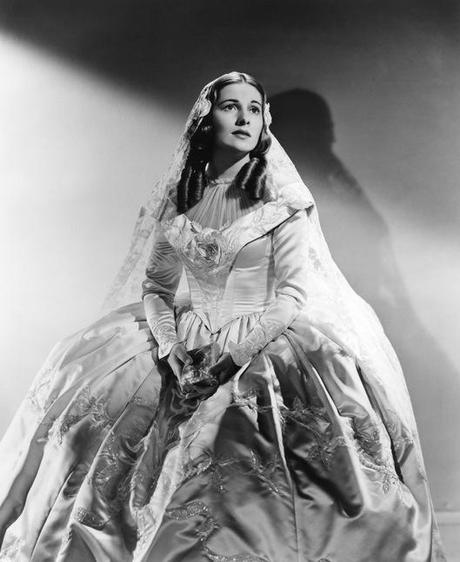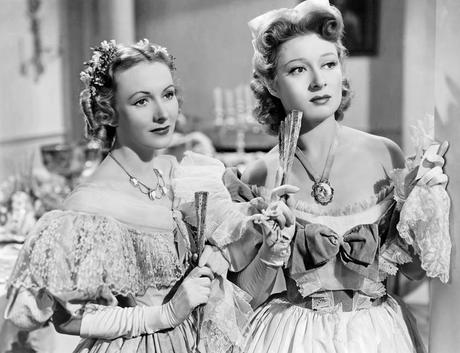
This isn’t a review per se, but rather an exhortation to acquire and read this book, How To Be A Heroine as soon as possible as it is seriously ace and a definite must read for any bookworm out there who has a tendency (and don’t we all?) to fall headlong in love with heroines.
I mean, don’t we all have a terrific crush on Lizzie Bennet and hasn’t every teenage girl wanted to be one of the Fossil sisters, get swept away by a Brontë hero (until we grew up and realised that Brontë heroes tend to be thumping great narcs with serious issues and a blank spot where it comes to personal hygiene), wished we could slap Jo Marsh for turning the lovely Laurie down, fall in love in Florence like Lucy Honeychurch or thought that The Bell Jar was all about them? Even to the point of wishing that our houses had decking to crawl under? Okay, maybe that last one was just me.

Merle Oberon and Laurence Olivier in Wuthering Heights, 1939.
‘On a pilgrimage to Wuthering Heights, Samantha Ellis found herself arguing with her best friend about which heroine was best: Jane Eyre or Cathy Earnshaw. She was all for wild, passionate Cathy; but her friend found Cathy silly, a snob, while courageous Jane makes her own way.
And that’s when Samantha realised that all her life she’d been trying to be Cathy when she should have been trying to be Jane.
So she decided to look again at her heroines – the girls, women, books that had shaped her ideas of the world and how to live. Some of them stood up to the scrutiny (she will always love Lizzy Bennet); some of them most decidedly did not (turns out Katy Carr from What Katy Did isn’t a carefree rebel, she’s a drip). There were revelations (the real heroine of Gone with the Wind? It’s Melanie), joyous reunions (Anne of Green Gables), poignant memories (Sylvia Plath) and tearful goodbyes (Lucy Honeychurch). And then there was Jilly Cooper…
How To Be A Heroine: Or, what I’ve learned from reading too much is Samantha’s funny, touching, inspiring exploration of the role of heroines, and our favorite books, in all our lives – and how they change over time, for better or worse, just as we do.‘

Vivien Leigh in Gone with the Wind, 1939.
Part memoir of her life as the daughter of Iraqi-Jewish refugees, part amusing study of some of the most iconic literature of our times, part hunt for the perfect heroine, this is a really great read that immediately shot to the very top of my personal ‘Books That I Wish I’d Thought Of First’ list, mainly because, with one or two swaps in and out, Samantha Ellis’ list of defining heroines is much the same as the one I would come up with but also because I think we’ve come to the same, and in some cases possibly contentious and unpopular, conclusions about rather a lot of them. Possibly it helps that I get the feeling that Ellis and I are roughly the same age so there’s possibly a lot of shared cultural influence going on – in my case, I was always FAR more about riotgrrrl than the Spice Girls so that while growing up in the eighties and nineties, I was instinctively drawn to heroines who struggled, made bad decisions, destroyed things and sat about with mascara streaming down their cheeks after yet another self inflicted disaster, all of which I read against a soundtrack of Hole, Babes in Toyland and L7.
And it certainly never fails to intrigue me how I read characters and their motivation completely differently now as an adult – although I think Hell will freeze over before I feel quite ready to completely accept that Jo Marsh was right to turn Laurie down and leave him free for the obnoxiously egotistical Amy (and what ARE limes anyway?). I’m glad though that the scales have fallen from my eyes about Cousin Helen in What Katy Did – as a little girl, I thought she was wonderful and aspired to be as good and gentle and long suffering as she but now I think she is awful, insufferable, preachy and whiny. I mean, what sort of woman do you have to be to be so pleased about your fiancé buggering off and marrying your best friend after you’ve ended up losing the use of your limbs?

Joan Fontaine in Jane Eyre, 1944.
One thing that How To Be A Heroine underlines for me is that our readings of heroines and, crucially, what makes them so is very much influenced by our own experiences and backgrounds. In my case, I was raised from very early babyhood by my maternal grandparents who banned me from reading most children’s books (although luckily Anne of Green Gables, Little Women and What Katy Did didn’t make it on the banned list) and instead insisted upon precocious readings of the Brontës, Dickens and Austen and their ilk at a time when I wasn’t really equipped to fully understand what made the characters tick. I remember really relating to Anne Shirley, another apparently unwanted, displaced girl with red hair, and am pleased to find that I still find her loveable now. I’m less enamoured with Catherine Earnshaw these days though – seeing her not so much as damaged and romantic as a damaging, narcissistic, self indulgent snob.
There’s a big change too in the way that I view Scarlett and Melanie in Gone with the Wind – I was actually named for the latter thanks to my Gone with the Wind loving grandmother and was always faintly appalled by this as to my mind, Melanie was the BORING one whereas Scarlett was an exciting, glamorous, tough, bombshell. Now though my views are very different and I think that actually it is Melanie that I admire the most out of the two as what I saw as ‘boring’ was actually loyalty, dependability and a deep inner strength. Plus there’s the fact that my family thought it cruelty to name a baby born with a head of tangerine orange hair, Scarlett…
In summary therefore, this is a really great and entertaining book that will make you think long and hard about the heroines that you have fallen for over the years, maybe reevaluate your feelings for them but certainly see them with fresh eyes, warts and all. It’s certainly made me want to rush off and reread Lace, which as a teenager I just enjoyed as a racy read with lots of strong female characters but now seems to me to be a lot more substantial from a feminist point of view and clearly begging for a re-read.

Greer Garson and Karen Morley (here playing possibly the prettiest Charlotte Lucas of all time!) in Pride and Prejudice, 1940.
So who are your favorite heroines and have you changed your mind about any of them over the years?
******
‘Frothy, light hearted, gorgeous. The perfect summer read.’ Minette, my young adult novel of 17th century posh doom and intrigue is now £2.02 from Amazon UK and $2.99 from Amazon US.
Blood Sisters, my novel of posh doom and iniquity during the French Revolution is just a fiver (offer is UK only sorry!) right now! Just use the clicky box on my blog sidebar to order your copy!
Follow me on Instagram.
